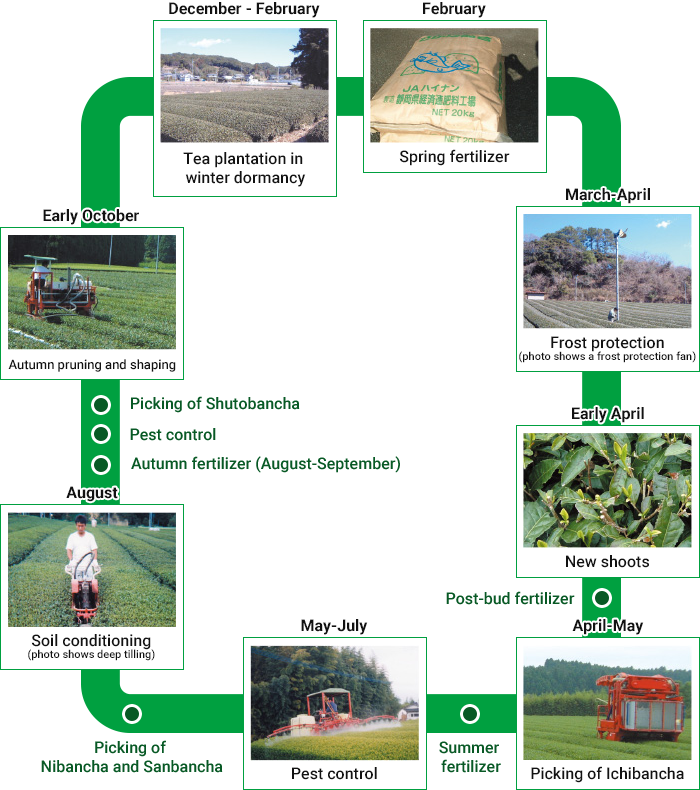Japanese Green Tea
Cultivation Method
How Tea Bushes Are Raised
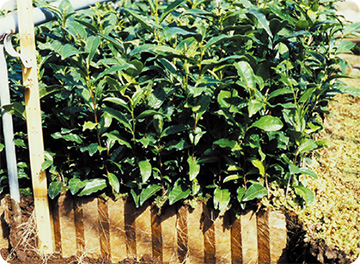
1. Raising seedlings
Tea plants are usually propgated from cuttings. Although the time of year at which cuttings are taken varies somewhat depending on the region and cultivar variety, June is the normal time in the case of summer cuttings and September to October is the standard time for autumn cuttings. Usually, two-year-old seedlings are transplanted to their final location in the tea plantation. Paper pots (internal diameter: 5-6cm; depth: 15cm) are also used. In the case of potted seedlings, they are usually transplanted to the plantation after six months.
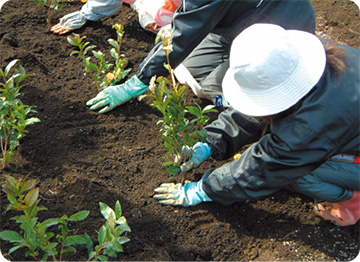
2. Fixed planting - transfering seedlings from the nursery to their permanent place in the field
March to April is the usual time for fixed planting. Several months before the seedlings are transplanted, underground irrigation tubes are laid and the soil is prepared through the application of compost and by deep plowing.*
* Deep plowing: Surface soil and subsoil is tilled (turned over) to a depth of approximately one meter and mixed together. This is said to improve the condition of soil beneath the tea bushes, which is difficult to condition after the tea plants are planted in their fixed position.
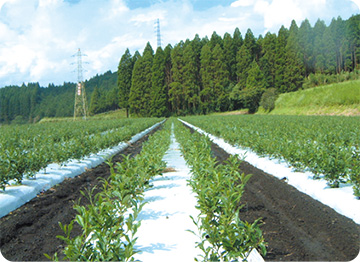
3. Management of the young tea bushes
It takes between four and eight years for the newly planted seedlings to reach maturity. Usually from the second year bushes are trained into the desired shape. Through pruning, the height of the main trunk is curbed and lateral branch growth is promoted. The objective of the pruning is to obtain even foliage cover at an early stage and expand the picking surface area. In the case of the Yabukita tea plant cultivar variety, pruning is done to a level of 15-20cm in the second year after fixed planting, 25-30cm in the third year and 35-40cm in the fourth year. In addition, because the young bushes have wide spacing between the rows, it is easy for weeds to grow rapidly. By laying PVC mulch sheeting or straw, the ground surface is covered, making it difficult for weeds to become established. Other weed control methods include tilling the surface soil, while the weeds are still small, to cut the weed roots.
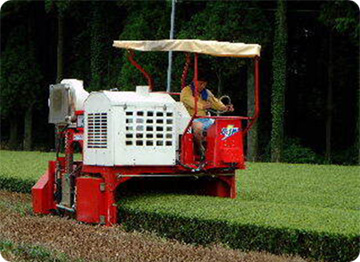
4. Tea picking
Although it becomes possible to pick the tea leaves from the fourth year, it is not until the fifth to eighth years that the width of the bushes and number of shoots provide stable yield and quality.* In regions such as Nansatsu in Kagoshima Prefecture that have a high number of pickings per year, there are five pickings annually - from Ichibancha to Yobancha plus Shutobancha. However, for Gyokuro and other bushes that use a natural shape, only one picking per year - Ichibancha - is carried out.
* Width of the bushes: Width of each row of tea bushes excluding the spacing between each row. For plantations using a conventional layout, this width is usually approximately 170cm.
Tea Raised through Work
Done over a Year
The number of annual hours of work required on a tea plantation per 10 ares (1,000㎡) is approximately 120 hours in Shizuoka Prefecture and 80 hours in Kagoshima Prefecture, the latter of which uses more mechanization. This work, in addition to picking, includes applying fertilizer, pest control, pruning and bush shaping, and for plantations that grow Kabusecha it is necessary to undertake cover culture-related work.
Tea Plantation's Annual Work Cycle
(Times of year indicated are based on a plantation in central Shizuoka Prefecture)
